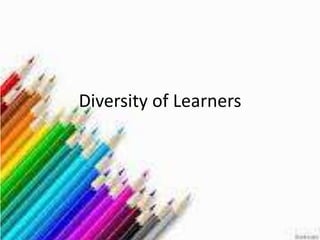
Diversity of learners
- 2. Learning and Thinking Styles • refer to the preferred way an individual processes information I. Sensory Preferences- individuals tend to gravitate toward one or two types of sensory inputs and maintain a dominance in one of the following types:
- 3. Visual Learners may think in pictures and learn best from visual aids like diagrams, illustrated textbooks, overhead transparencies, videos, flip charts and hand-outs a. Visual Iconic- prefer visual imagery like film, graphic display or pictures b. Visual Symbolic- prefer abstract symbolisms like written words or mathematical formula
- 4. 2. Auditory Learners learn best through verbal lectures, discussions, talking things through and listening to what others have to say a. Listeners- remember things said to them and make the information their own b. Talkers- prefer to talk and discuss 3. Tactile/Kinesthetic Learners prefer “learning by doing”, benefit much from hands-on approach, actively exploring the physical world around them
- 5. II. Global-Analytic Continuum 1. Analytic Learners- tend toward the linear, step-by-step processes of learning and see finite elements of patterns rather than the whole 2. Global Learners- lean towards non- linear and tend to see the whole pattern rather than particle elements
- 6. Multiple Intelligences (Howard Gardner) 1. Visual/ Spatial (Picture Smart) 2. Verbal/Linguistic (Word Smart) 3. Mathematical/Logical (Number/Logic Smart) 4. Bodily/Kinesthetic (Body Smart) 5. Musical/Rhythmic (Music Smart) 6. Intrapersonal (Self Smart) 7. Interpersonal (People Smart) 8. Naturalist (Nature Smart)
- 7. Exceptionalities These refer to learners who are different in some way from the normal or average. Most of these learners require a lot of understanding and patience as well as special education and related services if they are to reach their full potential and development.
- 8. 1. Mental Retardation and Developmental Disabilities 2. Learning Disabilities 3. Intellectual Differences (Gifted and Talented) 4. Emotional and Behavioral Disorders 5. Visual Impairment 6. Hearing Impairment 7. Oral Communication Problems 8. Orthopedic Impairments
- 9. Other Factors 1. Gender 2. Racial, ethnic or cultural background 3. Socioeconomic status
- 10. Applications in Teaching and Learning Process 1. Encourage learners to share their personal history and experiences. 2. Integrate learning experiences and activities which promote students’ multicultural and cross-cultural awareness. 3. Aside from highlighting diversity, identify patterns of unity than transcend group differences. 4. Communicate high expectations to students from all sub-groups. 5. Use varied instructional methods to accommodate student diversity in learning styles and multiple intelligences.
- 11. • Vary the examples you use to illustrate concepts in order to provide multiple contexts that are relevant to students from diverse backgrounds. • Adapt to the students’ diverse backgrounds and learning styles by allowing them personal choice and decision-making opportunities concerning what they learn and how will they learn from it. • Diversify your methods of assessing and evaluating student learning • 9. Purposely, form small-discussion groups of students from diverse backgrounds: different learning styles, multiple intelligences, different cultural background, etc